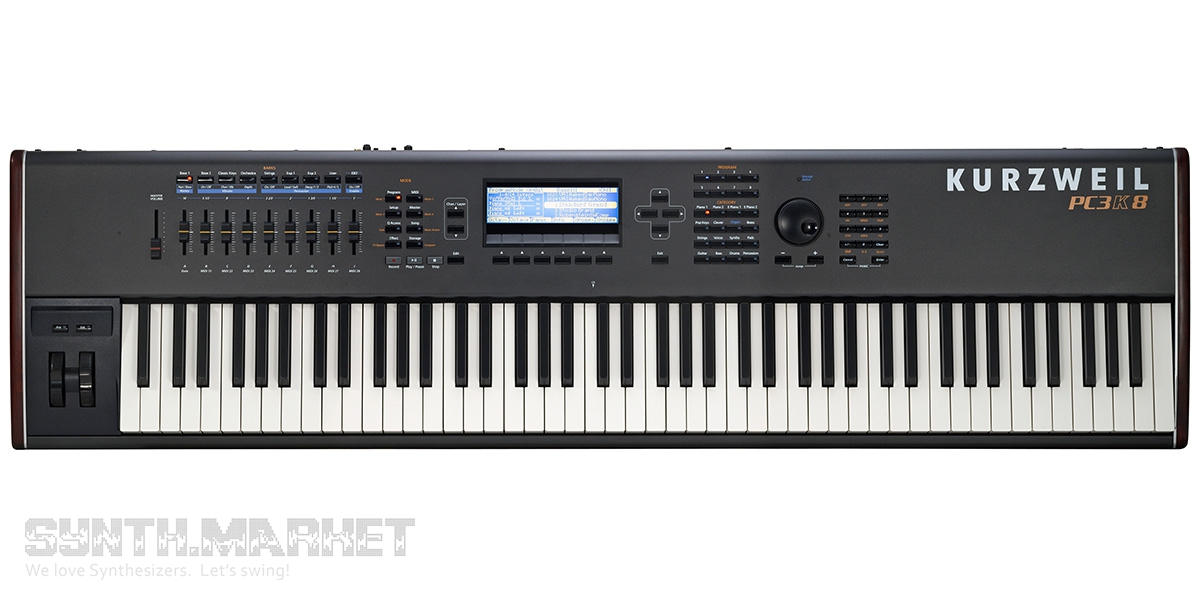Kurzweil PC3K units, like their PC2 predecessors and the K series starting with K2000, are built on a unique VAST engine (Variable Architecture Synthesis Technology) which often becomes an obstacle for users previously unfamiliar with VAST, who get lost in the richness of detailed settings and being scared away run Yamaha or Korg camp. VAST technology, and in particular its Dynamic VAST latest version, is very intriguing in terms of architecture and the possibility of expansions, and the sounds that the already improved PC3K series features are still considered to be the best ones among those offered by top workstations.
In addition to Dynamic VAST, the synthesis architecture of PC3K includes VA-1 audio engine and Kurzweil analog simulator that was going to be released in the late 2000s but it didn’t happen back then. VA-1 functions thanks to virtual analog "smoothing" oscillators which allow you to achieve greater voice realism. Besides, PC3K has a cascading mode that allows putting any layer through DSP processing of another layer in series or by mixing (up to 32 layers in total).
PC3K in many respects replicates PC3X system offering the same 128-note polyphony and 16-part multitimbrality, but now also supporting sample playback (128MB of memory, non-volatile), as well as a more efficient way of storing information and uploading via USB. PC3K allows you to download 8- and 16-bit AIFF and WAV files up to 96kHz and, even if the quality of the recording was doubtful, it will give a surprisingly decent result by letting them through the brand settings. Again Kurzweil PC3K pros and cons are about its heaped structure of insert/auxiliary/master effects which help to achieve an interesting sound sculpture, discover the versatility only Kurzweil workstation editing may offer. While digging deeper, it becomes clear why the company's latest instruments – PC3K – can compete with brands with more intuitive navigation.
You can get all the K2000/2500/2600 sounds on your PC3K – programs, setups, mapping and even samples are compatible and importable. The instrument conveys the subtle nuances of electric pianos and grand pianos (taking into account the texture of up to 32 possible layers). The synthesizer also has the KB3 mode (tone generator emulation), but due to the upgraded parameters and the DSP simulation, not all downloadable sounds will be available in this mode. Nevertheless, PC3K continues to attract customers with its obvious power features - the sound (emphasis on pianos, vintage keys, orchestral and synth sounds) and its processing.
Among disadvantages the scarce number of factory presets can be put there, as well as only 4 audio outputs, which are not so much for studio use, which makes it necessary to work with the audio method of loading samples. But powerful VAST processing and digital audio output make up for the limitations. Also a small monochrome display is hopelessly out of date and threatens with long menu navigation in search of the required option. But the keyboard is of excellent quality and made by the well-known Italian manufacturer Fatar - full-weight TP40-L, dynamic with aftertouch. You can also connect an external tape ribbon controller.
If the cost of PC3K workstation doesn’t seem reasonable to you, pay attention to PC3A and PC3LE series performance controllers. They don’t have a sampler, differ slightly in the number of presets and interfaces, they’re not fully compatible with K2 series, but they are cheaper and offer the most important thing which all the PC3 instruments were devised for - detailed fine tuning of the sounds using Dynamic VAST and professional use both in studio and on stage. PC3A initially has a KORE 64® sound generation engine on board, which is available for PC3K for an extra pay.
Given that Kurzweil company switched to Forte/Artis series, PC3K workstations may not have direct successors, so you’d better hurry with the purchase.
Tags: digital synthesizer


















